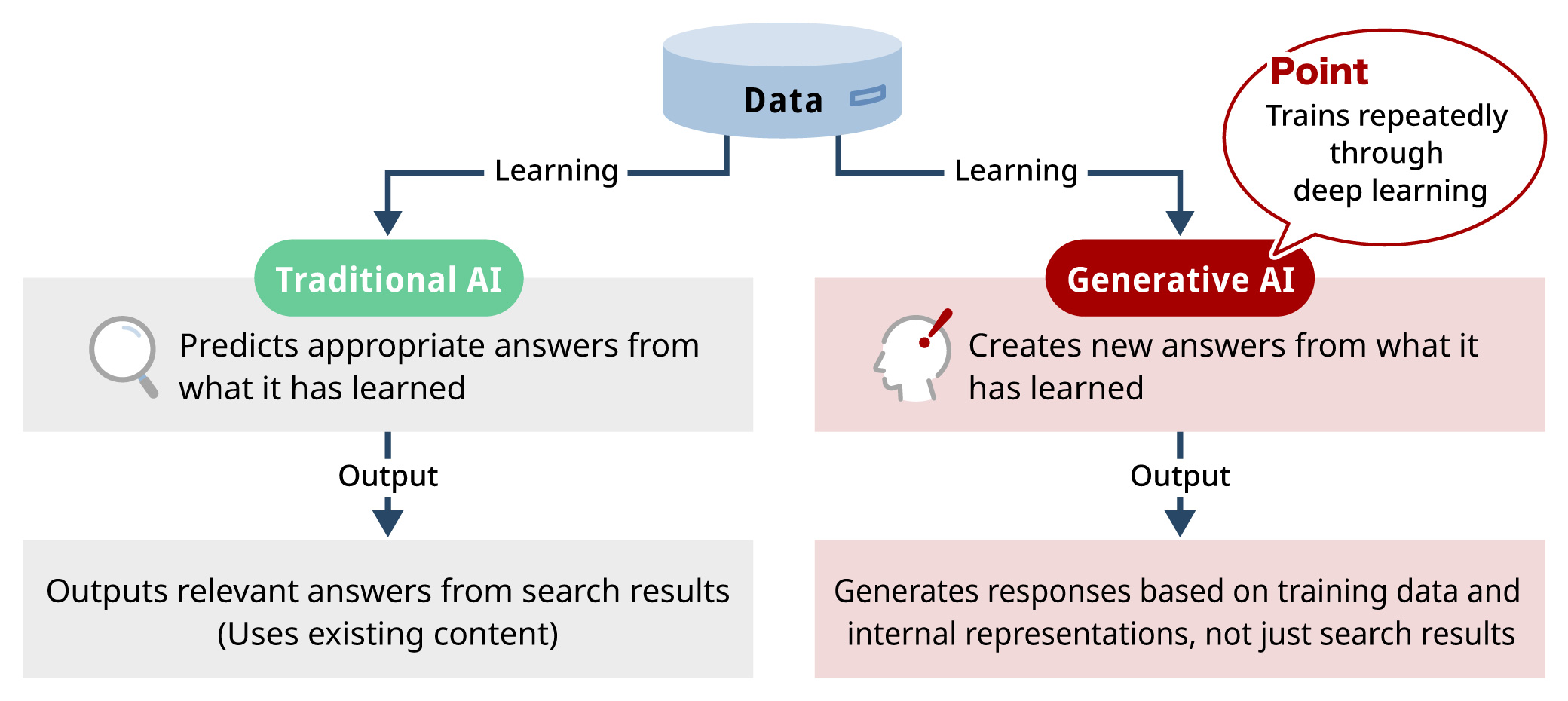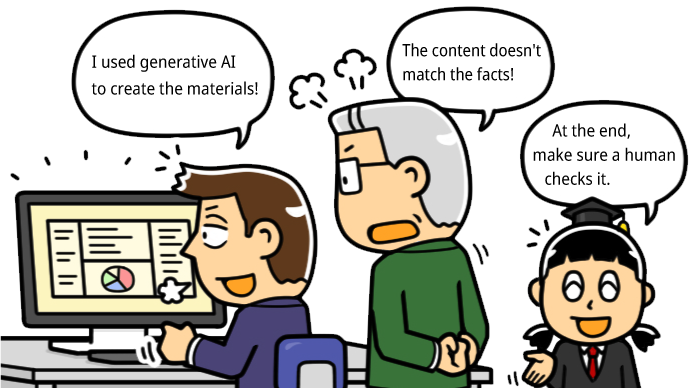with azbil
A to ZLearn with A to Z and everything will be clear! Keywords
Generative AI
Artificial intelligence that automatically generates text, images, music, videos, program code, and more using models trained on data. While conventional AI organizes and analyzes data provided to identify and predict information, generative AI can learn patterns and relationships from unstructured data and use them to create new content and generate ideas.

© Hiroyuki Hayashi
The fourth AI boom has brought generative AI that ordinary people can use
In recent years, artificial intelligence (AI) technology known as generative AI has advanced dramatically, becoming a familiar part of our daily lives. There are many services that use generative AI. For example, some smartphone voice assistants and smart speakers incorporate generative AI technology to provide more natural responses to questions.
The history of AI is long, and in 1956, the term “artificial intelligence” was coined by American computer scientist John McCarthy to describe the idea of computer programs that could simulate aspects of human intelligence. The first boom occurred in the 1960s when programs capable of playing games like mazes and chess were developed in the United States and the United Kingdom. Then, the second AI boom took place in the 1980s, with the research and development of expert systems that could solve problems using large amounts of input knowledge. The third boom began around 2000, when AI began to learn from vast amounts of data, including information from the internet, to learn. With deep learning, it became capable of identifying characteristics of target subjects and making inferences based on that information. As a result, advanced recognition and prediction, which were challenging for traditional rule-based AI, became possible.
The emergence of generative AI sparked the fourth AI boom, which is said to have begun around 2022. This generative AI is characterized by its ability to automatically generate original content, such as text and images, based on the data it has learned, distinguishing it from traditional AI. Until now, AI primarily focused on information analysis and prediction, but generative AI is trained using deep learning to generate new content and answers. Furthermore, since the introduction of ChatGPT by the U.S. company OpenAI* in 2022, AI has become accessible not only to experts but also to the general public, without requiring specialized knowledge.

Mastering it can lead to reduced workload and increased automation of tasks
There are various types of generative AI, including AI that primarily generates text, as well as those for image generation, video generation, audio generation, and program code generation. Some tools can perform multiple types of generation.
This type of generative AI can be used in various aspects of everyday work. For example, text-generating AI can be used to create meeting minutes, proofread reports, refine proposals, generate slogans, and assist with brainstorming.
Image-generating AI can extend photo backgrounds, and audio-generating AI can automatically add narration to videos. If you’re using AI that can generate source code, it can automatically create usable program source code with just specific instructions. For example, by simply giving instructions like “I want to create a simple timer app,” the source code can be displayed on the screen in a matter of seconds. It can also modify existing source code, and when there might be bugs, you can give instructions like “Identify the part of this code that is incorrect,” enabling the identification of the problematic areas.
The keys are giving appropriate prompts and how you handle the information
One of the features of generative AI is that it can be used simply by giving verbal instructions, even without IT skills. However, using it effectively requires the ability to give appropriate instructions, known as prompts. When dealing with complex tasks, some generative AI models (e.g., ChatGPT) can use logical steps called a “Chain of Thought” to arrive at a solution. For the “Chain of Thought” to work properly, it is important to clearly specify the goal and the desired output in your prompt. By providing additional instructions based on its outputs, you can refine the results to achieve a higher-quality solution that closely matches your desired outcome.
However, there are some things you should be careful about. These include information leaks, the accuracy of facts, and, with image and audio-generating AI, the infringement of intellectual property rights.
For example, if highly confidential information, such as internal company secrets or personal data, is included in prompts, it might be used to improve the model and could potentially be reflected in future outputs to other users. One way to prevent this is to specify during the setup stage that the data will not be used for learning purposes. Regarding the accuracy of facts, there is a phenomenon known as hallucination, where the AI generates plausible-sounding but factually incorrect or fabricated information. Therefore, it is important for users to verify the accuracy of the output themselves, keeping in mind that the information provided is not always correct.
The application of generative AI in the business sector is also progressing rapidly. For example, it is already being used to suggest products based on reviews on e-commerce websites, and to transcribe interviews with customers, extracting necessary information and compiling it into reports for related departments. In the future, generative AI is expected to evolve from a tool for improving work efficiency to one that complements and expands human creativity. Anticipated applications include analyzing medical records and generating treatment plans, as well as simulating urban planning.

*ChatGPT is a trademark of OpenAI OpCo, LLC.
- *This article was translated from the Japanese version of the article published on April 1, 2025.

 Related information
Related information

